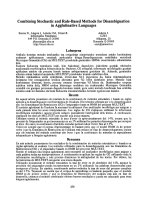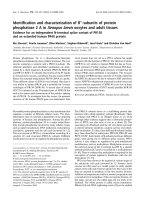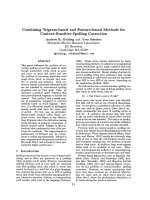In situ forming supramolecules and chitosan based hydrogels for regenerative medicine
Bạn đang xem bản rút gọn của tài liệu. Xem và tải ngay bản đầy đủ của tài liệu tại đây (3.99 MB, 140 trang )
A dissertation for the degree of doctor of philosophy
Stimuli responsive PEGylated nano-assemblies for cancertargeted drug delivery
Department of Molecular Science and Technology
The Graduate School of Ajou University
Dai Hai Nguyen
Stimuli responsive PEGylated nano-assemblies for cancertargeted drug delivery
Supervisor: Professor Ki Dong Park
A Dissertation
Submitted to the Graduate Faculty in Partial Fulfillment of the
Requirements for the Degree of Doctor of Philosophy
June 2013
Department of Molecular Science and Technology
The Graduate School of Ajou University
Dai Hai Nguyen
Acknowledgement
I wish to express in this part my gratitude to the scientists, technicians and other
people who were directly and indirectly involved in this work, without the help of whom
the findings of this thesis surely could not have been done.
First and foremost, I would like to extend immeasurable gratitude to Professor Ki
Dong Park, for giving me the opportunity to do my PhD thesis under his supervision. I
greatly appreciated his supervision for teaching, advising and supporting me throughout
my work. I am very grateful for his extreme patience and encouragement during the most
stressful time when my results were not good. He is a respectable mentor who has kindly
supported me in the name of family. It was an honor to work under his supervisor.
I am grateful to my thesis committee members, Professor Sung-Hwa Yoon,
Professor Won-Hee Suh at Ajou University, Professor Ji Hoon Jeong at Sungkyunkwan
University, Dr. In Kwon Jung at Genoss Company for their numerous suggestions and
helpful advice. This is a good opportunity to express my gratitude to Professors at Ajou
University whose teaching and advice helped me to complete my PhD coursework.
I would especially like to thank Dr. Yoon Ki Joung who has supported for me for
about three years. He kindly and friendly guided me from laboratory studies to routine
life in Korea. I also have deep gratitude towards Dr. Jin Woo Bae for being a great mentor.
His scientific comments are always useful in doing experiments, preparing presentation,
and writing a scientific paper.
I would like to thank my Vietnamese Professors Thi Phuong Thoa Nguyen, Thi
Kieu Xuan Huynh, and Huu Khanh Hung Nguyen for giving this opportunity to me, who
taught me fundamental knowledge of chemistry at University of Science-HCMC.
I especially appreciate all supports of my past and current members in Biomaterial
and Tissue Engineering Laboratory: Dr. Kyoung Soo Jee, Dr. Jin Woo Bae, Dr. Dong
Hyun Go, Dr. Jung Seok Lee, Dr. Kyung Min Park, Dr. Se Jin Son, Dr. Ngoc Quyen Tran,
Dr. Eugene Lih, Jong Hoon Choi, Yeo Jin Jun, In Kyu Hwang, Bae Young Kim, Ji Ho
Heo, Seung Soo You, Ki Seong Ko, Ji Hye Oh, Seung Mee Hyun, Dong Hwan Oh, Joo
Young Son, Yun Ki Lee, Ji Ho Kim, Min Yong Eom, Thi Thai Thanh Hoang, Thi Phuong
Le. I hope all members in BT Lab will obtain the outstanding achievement in your dream
and get the happiness in their life.
I appreciate all help of my Vietnamese best friends in Korea, Minh Dung Truong,
Van Thinh Nguyen, Dinh Chuong Pham, Ngoc Hoi Nguyen, Thanh Quy Nguyen, Hung
Cuong Dinh, Thi Hiep Nguyen, Chan Khon Huynh, who helped in several experiments
such as XRD, AFM, DLS, Confocal, FACS, cell culture, and animal studies. Without
them this thesis surely would not have been so multifaceted and prolific. I also would like
to be thankful to Korean friends in School of Engineering, Medicine School for your help
and support me during my stay here. Good luck to all of them.
Korean life could be some times stressful and tough, with all the competitiveness
and perfectionism. Luckily, I have had extensive care, support, and help from my family
and friends, who shared with me many wonderful and unforgettable moments throughout
my time here. I would like to devote this thesis to them with my sincere gratitude.
I would like to thank many of my best friends, Hoang Duy Nguyen, Minh Triet
Thieu, Hoang Chuong Nguyen, Nhat Nguyen Nguyen, Xuan Huong Ho… With them I
shared the first journey to Korea, as well as the sadness of leaving our lovely home and
country.
All this would not be possible without my loving immediate family. For good or
for bad, they are the ones who always stand behind me, and let me know that I am not
alone. Finally, deeply from my heart, I would like to thank my parents who believe and
support me at all time.
My best regards to all,
Dai Hai Nguyen
Abstract
Cancer is one of the leading causes of death worldwide and chemotherapy is a major
therapeutic approach for the treatment which may be used alone or combined with other
forms of therapy. However, conventional chemotherapy has the potential to harm healthy
cells in addition to tumor cells. Using targeted nanoparticles to deliver chemotherapeutic
agents in cancer therapy offers many advantages to improve drug delivery and to
overcome many problems associated with conventional chemotherapy. This work covers
the general areas of responsive nanocarriers and encompassed methods of fabricating
nanocarrier-based drug delivery systems for controlled and targeted therapeutic
application.
Chapter 1 provides general information of cancer and cancer treatment strategies. The
recently cancer treatment based on nanocarrier were introduced. In addition, the special
features as well as requirements of nanoparticles for targeted drug delivery were
presented. This chapter describes overall objectives of this study with the current status of
stimuli-responsive self-assembled nanocarriers for cancer chemotherapy. In chapter 2,
self-assembled nanogels based on reducible heparin-Pluronic copolymer was developed
for intracellular protein delivery. Heparin was conjugated with cystamine and the
terminal hydroxyl groups of Pluronic were activated with the VS group, followed by
coupling of VS groups of Pluronic with cystamine of heparin. The chemical structure,
heparin content and VS group content of the resulting product were determined by 1H
i
NMR, FT-IR, toluidine blue assay and Ellman's method. The HP conjugate showed a
critical micelle concentration of approximately 129.35 mg L−1, a spherical shape and the
mean diameter of 115.7 nm, which were measured by AFM and DLS. The release test
demonstrated that HP nanogels were rapidly degraded when treated with glutathione.
Cytotoxicity results showed a higher viability of drug-free HP nanogel than that of drugloaded one. Cyclo(Arg–Gly–Asp–D-Phe–Cys) (cRGDfC) peptide was efficiently
conjugated to VS groups of HP nanogels and exhibited higher cellular uptake than
unmodified nanogels. In chapter 3, stimuli–responsive Pluronic micelles is developed for
targeting cancer chemotherapy. In particularly, the role of crosslinking disulfide bond and
hydrazone bond in arrangement of environmental stimuli including redox and pH were
discussed. Specifically, acrylic acid was grafted onto PPO blocks of Pluronic by
dispersion/emulsion polymerization and used to introduce thiol groups as well as
hydrazine groups. DOX was conjugated to the hydrazone groups to achieve the pHtriggered release. The micelles were crosslinked by the formation of disulfide bonds due
to the presence of thiol groups on the polymer backbones. The physico-chemical
properties of the micelles were characterized. In vitro release studies were performed to
investigate pH-dependent release of DOX from the Pluronic micelles. FA was conjugated
to the Pluronic polymer for targeting cancer cell. FA conjugated micelles were compared
with the micelles without FA using confocal laser scanning microscopy (CLSM) and flow
cytometry. The Pluronic micelles functionalized with FA targeting ligand on the surface
showed the enhanced cellular uptake. In chapter 4, self-assembled magnetic nanoparticles
ii
(SAMNs) were fabricated from β-cyclodextrins functionalized superparamagnetic iron
oxide (SPIO@CD), paclitaxel (PTX), adamantylamine-poly(ethylene glycol)-vinyl
sulfone (ADA-PEG-VS), and c(RGDfC) peptide for integrated cancer cell-targeted drug
delivery. In this approach, PTX and ADA-PEG-VS enabled the host-guest inclusion with
SPIO@CD to form PEG-ADA:SPIO@CD:PTX SAMNs. Furthermore, cyclo(Arg-GlyAsp-d-Phe-Cys) (c(RGDfC)) peptide, a targeting ligand, could conjugate onto the VS
groups of the PEG arms of SAMNs. The architecture of SAMNs were characterized FTIR, TEM, and thermo gravimetric analysis (TGA), which confirmed that PEG, CD have
been effectively functionalized on the surface of SPIO nanoparticles. SAMNs were
enabling to be controlled over the sizes, surface chemistry, payloads of supramolecular
nanoparticle vector. The sizes, drug entrapment efficiency (DEE), drug loading efficiency
(DLE), and SIPO encapsulation of SAMNs could turn by changing its components. In
vitro PTX release profile from SAMNs was highly ADA response. Cumulative releases of
PTX from SAMNs were 44.1% and 9.6% with and without ADA treatment after 120 h.
Most importantly, the analyses of vibration sample magnetometer (VSM) verified that the
magnetic property of SAMNs was increased under the external magnetic field.
c(RGDfC)-conjugated SPIO nanocarriers exhibited a higher level of cellular uptake than
unmodified ones in vitro according to flow cytometry and confocal laser scanning
microscopy (CLSM).
iii
Table of Contents
Abstract ............................................................................................................................ i
Table of Contents .......................................................................................................... iv
List of Figures .............................................................................................................. viii
List of Tables..................................................................................................................xv
Chapter 1. General introduction ...................................................................................1
1. Cancer and strategy treatment .......................................................................................2
2. Nanocarrier strategies in cancer chemotherapy ............................................................5
3. Self-assembled nanocarrier for drug delivery ...............................................................6
4. PEGylated nanocarriers for systemic deliver ................................................................9
5. Targeted drug delivery systems for cancer therapy. ....................................................13
5.1. Passive targeting strategies and recent developments....................................15
5.2. Active targeting strategies and stimuli-triggered ligand presentation............16
6. Stimuli-response for controlled drug delivery ............................................................18
6.1. Concepts for designing stimuli-responsive nanoparticles..............................18
6.2. Previous studies of stimuli-response for controlled drug delivery ................26
7. Overall objectives .......................................................................................................28
8. References ...................................................................................................................30
iv
Chapter 2. Self-assembled nanogels based on reducible heparin-Pluronic
copolymer for targeted protein delivery .....................................................................35
1. Introduction .................................................................................................................36
2. Materials and methods ................................................................................................40
2.1. Materials ............................................................................................................40
2.2. Synthesis of copolymers and preparation of drug loaded nanogels ...................40
2.3. Polymer characterizations ..................................................................................44
2.4. In vitro release test .............................................................................................47
2.5. Cytotoxicity assay ..............................................................................................47
2.6. Intracellular uptake study...................................................................................47
2.7 Statistical analysis ...............................................................................................48
3. Results and Discussion ...............................................................................................50
3.1. Characterization of polymers and nanogels .......................................................50
3.2. CMC and size distribution of nanogels ..............................................................51
3.3. In vitro release profiles of RNase A and heparin ...............................................55
3.4. Cytotoxicity of RNase A-loaded nanogels .........................................................55
3.5. Cellular uptake of HP−RGD nanogels ...............................................................58
4. Conclusions .................................................................................................................61
5. References ...................................................................................................................62
Chapter 3. pH- and redox-stimuli sensitive Pluronic micelle for targeted
v
doxorubicin delivery .....................................................................................................65
1. Introduction ...............................................................................................................66
2. Materials and methods ................................................................................................70
2.1. Materials ............................................................................................................70
2.2. Synthesis of copolymers and preparation of micelles........................................70
2.3. Micelle characterizations ...................................................................................73
2.4. In vitro DOX release ..........................................................................................73
2.5. Cytotoxicity assay ..............................................................................................74
2.6. In vitro intracellular uptake study ......................................................................74
2.7. In vivo tumor growth inhibition study ...............................................................75
3. Results and Discussion ...............................................................................................77
3.1. Characterization of Pluronic conjugates ............................................................77
3.2. Analysis of intracellular uptake .........................................................................80
3.3. In vitro cytotoxicity............................................................................................84
3.4. In vivo tumor growth inhibition .........................................................................88
4. Conclusions .................................................................................................................90
5. References ...................................................................................................................91
Chapter 4. Self-assembled magnetic nanoparticles based on host-guest inclusion
for targeted paclitaxel delivery ....................................................................................95
1. Introduction .................................................................................................................96
vi
2. Materials and methods ................................................................................................98
2.1. Materials ............................................................................................................98
2.2. Synthesis and preparation of SAMNs ................................................................99
2.3. Characterizations..............................................................................................103
2.4. In vitro PTX release test...................................................................................106
2.5. In vitro intracellular uptake study ....................................................................106
3. Results and Discussion .............................................................................................107
3.1. Characterization ...............................................................................................107
3.2. In vitro release test ........................................................................................... 112
3.3. In vitro cellular uptake ..................................................................................... 113
4. Conclusions ............................................................................................................... 116
5. References ................................................................................................................. 117
vii
List of Figures
Figure 1.1.
Overview of the clinically most relevant drug targeting strategies. (A)
Conventional chemotherapy (free drug) (B) passively targeted drug
delivery system by virtue of the enhanced permeability and retention
(EPR) effect (C) Active drug targeting to internalization-prone cell
surface receptors (over)expressed by cancer cells generally intends to
improve the cellular uptake of the nanomedicine systems (D) Active drug
targeting to receptors (over)expressed by angiogenic endothelial cells
aims to reduce blood supply to tumours (E) Stimuli-sensitive
nanomedicines (F) Local drug delivery.
Figure 1.2.
Example of self-assembled nanocarriers for targeted drug delivery: a.
Micelles, an aggregate of surfactant molecules dispersed in a liquid
colloid where drugs are physically encapsulated in the inner core. b.
Liposomes, a spherically arranged bilayer structure with drug loaded
either in the inner aqueous phase or between the lipid bilayers. c.
Oil/water emulsion, a mixture of liquids that are normally immiscible
with drug loaded in the inner oil phase. d. Nanocapsules, a polymeric
membrane which encapsulates an inner liquid core. e. Nanogels, a
nanoparticle composed of a hydrogel. f. Core-shell particles, the location
of nanocrystals at the core with the polymers on the outer layer.
viii
Figure 1.3.
(a) Nanocarriers (a1) are coated with opsonin proteins (a2) and associate
with macrophages (a3) for transit to the liver (a4). Macrophages
stationary in the liver, known as Kupffer cells, also participate in
nanoparticle scavenging. (b) Nanocarriers coated with PEG coating (b1)
prevents this opsonization (b2), resulting in decreased liver accumulation
(b3) and increased availability of the NP for imaging or therapy.
Figure 1.4.
Conceptual representation of nanoparticle tumor-targeting modalities.
Passive targeting: Unlike that found in normal tissue, tumor vasculature
is leaky owing to fenestrations and gaps between endothelial cells that
result from abnormal angiogenesis. NPs in circulation can passively
extravasate through these gaps and enter the tumor interstitium. Poor
lymphatic drainage found in some tissues helps to retain particles in the
tumor space. Active targeting: Ligands (e.g. antibodies, peptides, small
molecules, etc.) targeted toward moieties overexpressed or uniquely
present on the plasma membrane of tumor cells can be used to actively
enhance NP accumulation at the tumor site and can also help to
internalize particles into cells via endocytosis.
Figure 1.5.
Dual and multi-stimuli responsive polymeric nanocarriers as emerging
controlled drug release systems. There are two kinds of stimuli, broadly
defined, that can be engineered into delivery systems: internal stimuli
ix
(i.e., enzymatic reactions, changes in pH, redox, and temperature) and
external stimuli (i.e., heat, light, magnetic and electrical fields).
Figure 1.6.
Schematic illustration of block copolymer assemblies which can respond
to a range of stimuli characteristic of tumor tissues and intracellular
microenvironments, promoting targeted delivery and controlled release
of therapeutic drugs and imaging agents.
Figure 2.1.
Schematic illustration showing the formation and redox-sensitive
intracellular delivery of a protein-loaded HP nanogel.
Figure 2.2.
Synthetic route of heparin−SS−Pluronic−VS conjugate.
Figure 2.3.
1
H NMR (D2O) spectra of Pluronic−DVS (A), heparin−Cya (B), and
heparin−Cya−Pluronic−VS (C).
Figure 2.4.
FT-IR spectra of cystamine dihydrochloride (a), heparin (b), Pluronic (c),
heparin−Cya (d), Pluronic−DVS (e), heparin−Cya−Pluronic−VS (f).
Figure 2.5.
The determination of the CMC from the function of fluorescence
intensity ratios of I441.5 to I337.5 versus the log concentration of heparinCya-Pluronic-VS (pH 7.4).
Figure 2.6.
The size distributions (DLS) of nanogels of heparin−Cya−Pluronic−VS
(a) and RNase A-loaded heparin−Cya−Pluronic−VS (b) and the AFM
x
image of heparin−Cya−Pluronic−VS (c)
Figure 2.7.
Release profiles of heparin from heparin−Cya−Pluronic−VS nanogel (A)
and RNase A from RNase A-loaded heparin−Cya−Pluronic−VS nanogel
(B). Release studies were performed primarily in PBS media ((pH 7.4)
and then treated with GSH at final concentration of 5 mM at 37oC.
Experiments were performed three times and the data indicate
mean ± standard deviation.
Figure 2.8.
Cell viability of NIH3T3 cells incubated with heparin−Cya−Pluronic
−cRGDfC (♦) and RNase A-loaded heparin−Cya−Pluronic−cRGDfC (■)
nanogels for 48 h at 37 oC. The cell viability was determined by MTT
assay and plotted against the polymer concentration in DMEM at 37 oC.
Experiments were performed four times and significant differences
between the treatment means and control values at respective times are
indicated by * P < 0.05.
Figure 2.9.
Intracellular uptake of HP nanogels. Confocal microscopic images
of HeLa cells incubated with FITC-labeled heparin−Cya−Pluronic−VS
and FITC-labeled heparin−Cya−Pluronic−cRGDfC nanogels, which
were shown as blue (upper-left), green (upper-right) and merged (lower)
fluorescence.
xi
Figure 3.1.
pH- and redox potential-responsive Pluronic micelles for cancer-targeted
chemotherapy.
Figure 3.2.
A synthetic route to FA-Pluronic-C/H-DOX. (i) PNC, TEA, EDA, THF,
(ii) AA, AIBN, APS, (iii) TEMPO, MeOH (iv) FA, EDC, NHS, MES
buffer, (v) hydrazine, cystamine dihydrochloride, EDC, NHS, MES
buffer, vi) DTT, borate buffer, (vii) DOX, TEA, DMSO.
Figure 3.3.
1
Figure 3.4.
Intensity ratio of pyrene as a function of FA-Pluronic-C/H concentration.
Figure 3.5.
Time course changes in average diameter and size distribution of FA-
H NMR spectra of AA-Pluronic-NH2 (i) and FA-Pluronic-C/H (ii).
Pluronic-C/H-DOX micelles after DTT treatment (n = 4).
Figure 3.6.
In vitro release behaviors of DOX from micelles at different pH values.
DOX conjugated micelles (FA-Pluronic-C/H-DOX) at pH 7.4 (●) and pH
5.2 (■), DOX encapsulated micelles (FA-Pluronic-C/H/DOX) at pH 7.4
(○), or at pH 5.2 (□) (n = 4).
Figure 3.7.
Confocal microscopic images (a-f) of HeLa cells treated with various
DOX formulations at a concentration equivalent to 3 μg/mL of DOX.
Pluronic-C/H-DOX (a, b), FA-Pluronic-C/H-DOX (c, d), and free DOX
(e, f) were incubated with HeLa cells for 1 h (a, c, e) and 4 h (b, d, f).
xii
Flow cytometry histrogram (g) and fluorescence intensity (h) of various
DOX formulations internalized into HeLa cells for 4h.
Figure 3.8.
Dose-dependent cytotoxicity of (a) FA-Pluronic-C/H micelles and (b)
FA-Pluronic-C/H-DOX against HeLa cells after 48 h incubation (n = 4).
Free DOX (×), Pluronic-C/H-DOX (○), and FA-Pluronic-C/H-DOX (●)
were incubated with cells for 48 h.
Figure 3.9.
Tumor growth inhibition test and body weight change of s.c breast MCF7/ARD xenograft in female BALB/c mice (Mean ± standard error of the
mean, n = 5). Mice were dosed i.v. with saline (●), FA-Pluronic(SS) (■),
free DOX(▲), FA/DOX-Pluronic(SS) (×) (DOX 4.0 mg/kg) by tail vein
injection on days 0, 4, 8. The corresponding nanoparticle dose was 27.9
mg micelles/kg. (a) Tumor volume changes, (b) body weight changes,
and (c) Photos were taken on day 21 of our in vivo study.
Figure 4.1.
Schematic illustration for the fabrication of self-assembled magnetic
nanoparticles (SAMNs) with targeted drug delivery and magnetic
resonance imaging (MRI) contrast enhancement functions from βcyclodextrins functionalized superparamagnetic iron oxide (SPIO@CD),
paclitaxel (PTX), adamantylamine-poly(ethylene glycol)-vinyl sulfone
(ADA-PEG-VS),
and
cyclo(Arg-Gly-Asp-d-Phe-Cys)
xiii
(c(RGDfC))
peptide moieties.
Figure 4.2.
Synthetic routes employed for the preparation of ADA-PEG-VS and
DOPA-CD moieties.
Figure 4.3.
1
Figure 4.4.
FT-IR spectra of (a) bare Fe3O4 NPs; (b) DOPA-CD; (c) ADA-PEGVS, (d) SPIO@CD, (e) VS-PEG-ADA:SPIO@CD:PTX SAMNS.
Figure 4.5.
The particles size distribution of SPIO, SPIO@CD, and VS-PEGADA:SPIO@CD:PTX by DLS (a, b, and c) and by TEM (d, e, and f).
Figure 4.6.
In vitro characterization: (A) Magnetization curve of SIPO (white) and
SAMNs (black) at 298 oK measured by SQUID exhibiting magnetic
saturation, (B) Photograph of magnetic separation of SAMNs by a
magnet.
Figure 4.7.
In vitro PTX release profiles in PBS (pH 7.4) with (●) and without (■)
ADA from SAMNs.
Figure 4.8.
Confocal microscopic images (A) and fluorescence intensity (B) of HeLa
cells and c(RGDfC) pretreated HeLa celles incubated with c(RGDfC)PEG-ADA:SPIO@βCD:PTX SAMNs at 37 oC for 4 h.
H NMR spectra of DOPA-CD (A) and ADA-PEG-VS (B).
xiv
List of Table
Table 1.1.
Selected examples of ligands used in active drug targeting
xv
Chapter 1.
General introduction
1
1. Cancer and strategy treatment
Cancer is one of the leading causes of death worldwide (13%). Each year 12.7 million
people worldwide are diagnosed with cancer and there are 7.6 million deaths from the
disease in 2008 (WHO).1 It is estimated that there are 24.6 million people alive who have
received a diagnosis of cancer in the last five years. By 2030, the number of new cancer
cases is expected to rise to 21.4 million, with 13.15 million cancer deaths. 2 Cancer's total
economic impact was estimated at $895 billion in 2008, or 1.5% of the world's gross
domestic product. This cost did not include direct medical costs, which could potentially
double the total economic cost, according to Atlanta-based ACS.3
The cancer treatment during the twentieth century was based on surgery, radiation
and chemotherapy. Of these modalities, surgery is most effective at an early stage of
disease progression. However, most cancer operations carry a risk of: pain, infection, loss
of organ function. Surgery can also cause cancer cells to spread to different sites.
Radiation while destroying cancer cells also burns, scars, and damages healthy cells,
tissues, and organs. Initial treatment with chemotherapy and radiation will often reduce
tumor size. Radiation can cause cancer cells to mutate and become resistant and difficult
to destroy.4 Chemotherapy is drug therapy that can kill these cells or stop them from
multiplying. However, it involves poisoning the rapidly growing cancer cells and also
destroys rapidly growing healthy cells in the bone marrow, gastro-intestinal tract, etc.,
and can cause organ damage, like liver, kidney, heart and lungs, and so on. Moreover,
when the body has too much toxic burden from chemo the immune system is either
2
compromised, hence the person can succumb to various kinds of infections and
complications.
Consequently, novel targeted drug deliveries have been extensively investigated in an
effort to improve the therapeutic effectiveness and safety profile of traditional
chemotherapeutic agents. Targeted drug delivery, sometimes called smart drug delivery,
is a method of delivering medication to a patient in a manner that increases the
concentration of the medication in some parts of the body relative to others. The goal of a
targeted drug delivery system is to prolong, localize, target and have a protected drug
interaction with the diseased tissue. The conventional drug delivery system is the
absorption of the drug across a biological membrane, whereas the targeted release system
is when the drug is released in a dosage form. The clinically most relevant drug targeting
strategies were summarized in Figure 1.1. The advantages to the targeted release system
is the reduction in the frequency of the dosages taken by the patient, having a more
uniform effect of the drug, reduction of drug side effects, and reduced fluctuation in
circulating drug levels.
3
Figure 1.1 Overview of the clinically most relevant drug targeting strategies. (A)
Conventional chemotherapy (free drug) (B) passively targeted drug delivery system by
virtue of the enhanced permeability and retention (EPR) effect (C) Active drug targeting
to internalization-prone cell surface receptors (over)expressed by cancer cells generally
intends to improve the cellular uptake of the nanomedicine systems (D) Active drug
targeting to receptors (over)expressed by angiogenic endothelial cells aims to reduce
blood supply to tumours (E) Stimuli-sensitive nanomedicines (F) Local drug delivery.
4
2. Nanocarrier strategies in cancer chemotherapy
The use of nanotechnology in medicine and more specifically drug delivery is set to
spread rapidly. Currently many substances are under investigation for drug delivery and
more specifically for cancer therapy are used in the clinic. Interestingly pharmaceutical
sciences are using nanocarriers to reduce toxicity and side effects of drugs and up to
recently did not realize that carrier systems themselves may impose risks to the patient.
The kind of hazards that are introduced by using nanocarriers for drug delivery are
beyond that posed by conventional hazards imposed by chemicals in classical delivery
matrices. For nanocarriers the knowledge on particle toxicity as obtained in inhalation
toxicity shows the way how to investigate the potential hazards of nanocarriers. The
toxicology of particulate matter differs from toxicology of substances as the composing
chemical(s) may or may not be soluble in biological matrices, thus influencing greatly the
potential exposure of various internal organs.
Appropriately engineered nano-sized delivery systems can achieve finer temporal
control over drug release rates due to their large surface area. Nanocarriers can also be
inherently useful in systems that require a burst release. Nanocarriers, unlike bulk drug
delivery systems, can enter cells to deliver drugs and can be designed to respond to
intracellular cues. Further, since nanocarriers can circulate in the body after being
injected they have the ability to target diseases at the site of disorder. This feature of
nanocarriers is especially useful in cancer therapy, where the size of the delivery system
is the key to target cancers through the enhanced permeability and retention effect (EPR).
5









